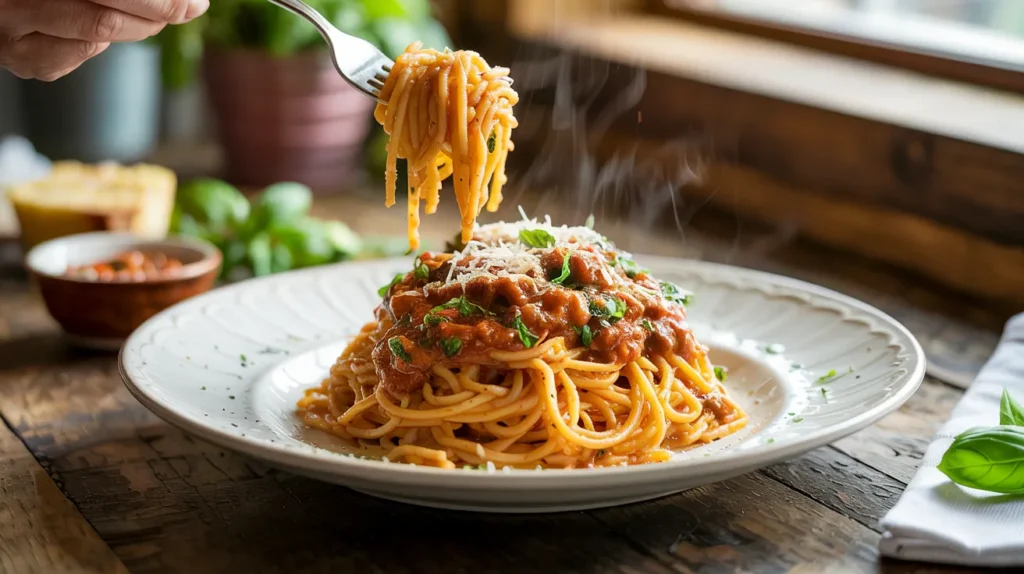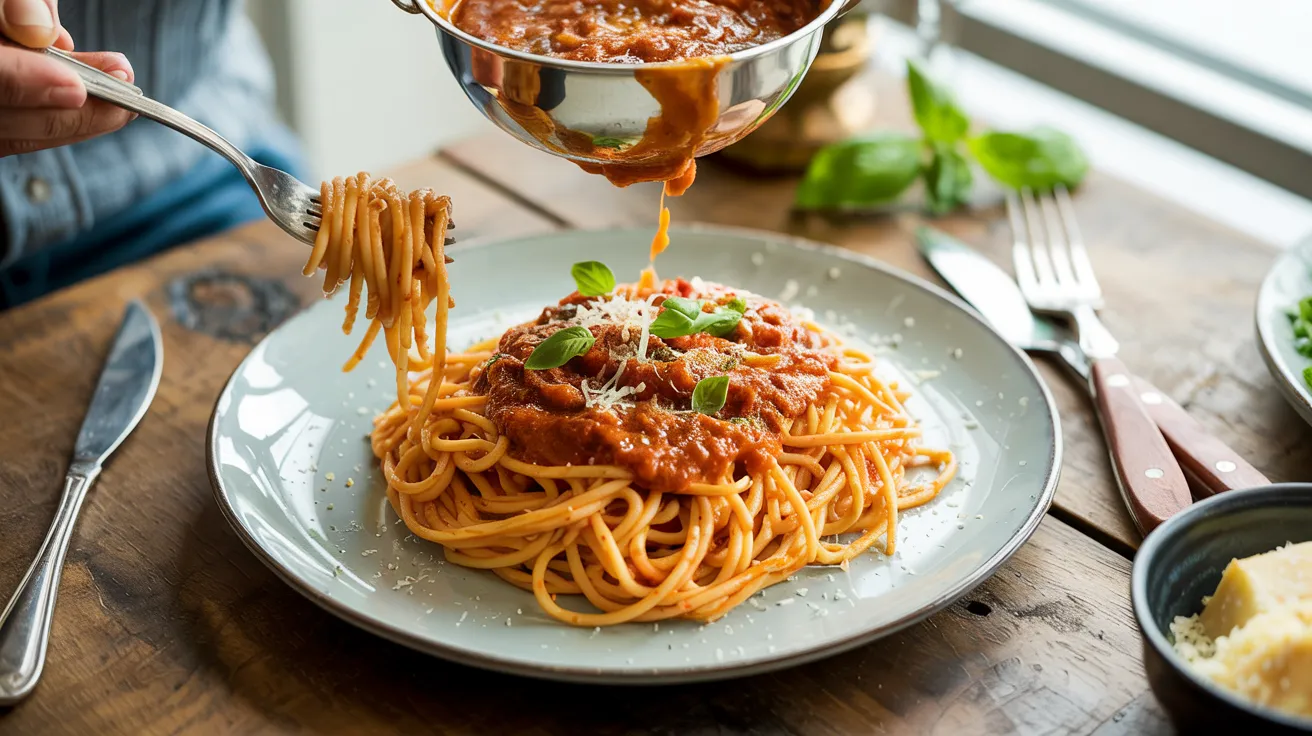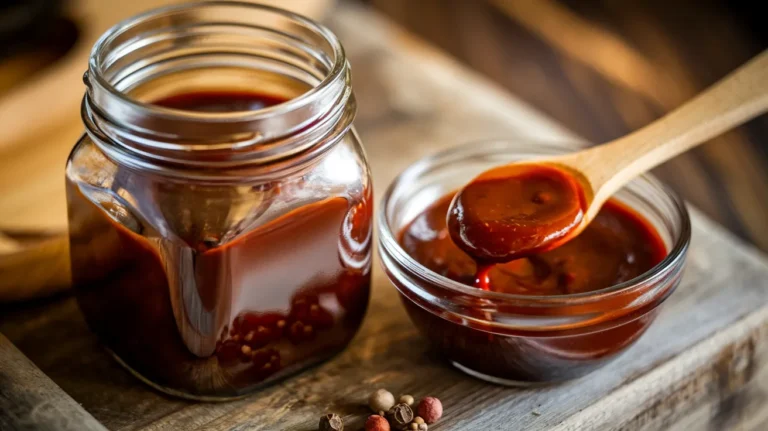- Ready in just 45 minutes – perfect for weeknight dinners
- Uses simple, fresh ingredients you probably already have
- Freezes beautifully for quick future meals
- Versatile base for countless Italian-inspired dishes
The Secret to Restaurant-Quality Silver Palate Pasta Sauce at Home
Have you ever tasted a pasta sauce so good it made you close your eyes and savor each bite? The legendary Silver Palate Pasta Sauce delivers exactly that experience.
This classic sauce has earned its reputation for a reason. The Silver Palate Pasta Sauce combines sweet tomatoes, aromatic herbs, and just the right balance of savory elements to create something truly special. Best of all? You can make it at home with simple ingredients.
No more settling for bland jarred sauces. With this recipe, you’ll create a sauce that’ll impress family and friends while fitting into your busy schedule. The Silver Palate Cookbook might have introduced this sauce to the world, but our version brings it right to your kitchen, sized perfectly for four people.
Let’s create something amazing together!
Nutrition Facts
| Nutrient | Amount Per Serving |
|---|---|
| Calories | 215 |
| Total Fat | 14g |
| Saturated Fat | 2g |
| Cholesterol | 0mg |
| Sodium | 620mg |
| Total Carbohydrates | 18g |
| Dietary Fiber | 4g |
| Sugars | 12g |
| Protein | 3g |
What You’ll Need
Ingredients
| Ingredient | Amount | Notes |
|---|---|---|
| Olive oil | 1/4 cup | Extra virgin preferred |
| Yellow onion | 1 medium | Finely diced |
| Garlic | 4 cloves | Minced |
| Canned whole San Marzano tomatoes | 28 oz can | Crushed by hand |
| Tomato paste | 2 tablespoons | Unsalted preferred |
| Red wine | 1/4 cup | Dry variety (Chianti works well) |
| Fresh basil | 1/4 cup | Chopped, plus extra for garnish |
| Dried oregano | 1 teaspoon | |
| Red pepper flakes | 1/4 teaspoon | Adjust to taste |
| Sugar | 1 teaspoon | Optional, to balance acidity |
| Salt | 1 teaspoon | Or to taste |
| Black pepper | 1/2 teaspoon | Freshly ground |
| Parmesan cheese rind | 1 piece (about 2 inches) | Optional but recommended |
Kitchen Equipment
| Tool | Purpose |
|---|---|
| Large, heavy-bottomed pot | For cooking the sauce |
| Wooden spoon | For stirring without scraping the pot |
| Sharp knife | For chopping ingredients |
| Cutting board | For prep work |
| Measuring cups and spoons | For accurate measurements |
| Can opener | For the tomatoes |
| Blender or immersion blender | Optional, for smooth sauce |
Possible Substitutions
- Canned tomatoes: Fresh tomatoes (2 pounds) can work, but will need longer cooking
- Red wine: 2 tablespoons balsamic vinegar or additional broth
- Fresh basil: 1 tablespoon dried basil (though fresh is strongly recommended)
- Parmesan rind: 2 tablespoons grated Parmesan added at the end
Step-by-Step Instructions for Beginners
Prep Time: 15 minutes
Cook Time: 30 minutes
Total Time: 45 minutes
Servings: 4
Preparation Phase
- Gather all ingredients and measure them out before starting.
- Take all ingredients out of your pantry and refrigerator.
- Place them on your counter for easy access.
- Use measuring cups for liquids (olive oil, wine) and measuring spoons for smaller amounts (herbs, spices).
- Open your cupboards and have your equipment ready to use.
- This organized approach is called “mise en place” (everything in its place) and will make cooking much easier.
- Prep the vegetables with careful attention to detail:
- For the onion:
- Cut off both ends with a sharp knife.
- Stand the onion on one flat end and cut in half from top to bottom.
- Peel off the papery outer skin.
- Place each half flat-side down on your cutting board.
- Make vertical cuts about 1/4 inch apart, but don’t cut all the way through the root end.
- Then make horizontal cuts parallel to the board.
- Finally, slice crosswise to create small, even diced pieces.
- For the garlic:
- Separate the cloves from the head.
- Place a clove on the cutting board.
- Lay the flat side of your knife on top of the clove.
- Gently press down with the heel of your hand to crush the clove slightly.
- The skin will now easily peel off.
- Mince the peeled garlic by making repeated cuts in different directions until very finely chopped.
- Keep your fingertips curled under to avoid cuts.
- For the fresh basil:
- Gently wash leaves under cold water.
- Pat dry with paper towels or use a salad spinner.
- Stack larger leaves on top of each other.
- Roll them up like a cigar.
- Slice across the roll to create thin ribbons (chiffonade).
- Then chop across these ribbons for smaller pieces.
- Set aside 1/4 cup measured after chopping.
- For the onion:
- Prepare the tomatoes with care:
- Place a large bowl in your sink or on a steady surface.
- Open the can of whole tomatoes with a can opener.
- Pour the entire contents (tomatoes and juice) into the bowl.
- Wash your hands thoroughly.
- Using clean hands, gently squeeze each tomato to break it apart.
- Don’t squeeze too hard or you’ll create splashes.
- Alternatively, use kitchen scissors to cut the tomatoes while they’re in the bowl.
- Make sure to keep all the juice – it’s full of flavor.
- If you prefer, you can roughly chop them on a cutting board instead.
- Return all tomatoes and juice to the bowl until needed.
Cooking Phase
- Heat the base properly:
- Choose a heavy-bottomed pot about 5-6 quarts in size.
- Place it on your stove over medium heat.
- Pour in the 1/4 cup olive oil.
- Allow it to warm up for about 1 minute.
- You’ll know it’s ready when the oil looks shimmery but isn’t smoking.
- To test, drop a tiny piece of onion into the oil – it should gently sizzle.
- If it browns immediately, your heat is too high; turn it down slightly.
- If nothing happens, let it heat a bit longer.
- Cook the aromatics to build flavor foundation:
- Once the oil is properly heated, carefully add all your diced onions.
- Spread them evenly across the pot’s surface.
- They should sizzle gently when added.
- Using your wooden spoon, stir to coat all onion pieces with oil.
- Cook for 5-7 minutes, stirring every 1-2 minutes.
- Watch for the onions to become translucent (you can see through them) and soft.
- They shouldn’t brown much – if they start to, lower your heat slightly.
- Once onions are soft and translucent, add all of your minced garlic.
- Stir constantly for exactly 30 seconds.
- Garlic burns easily and becomes bitter, so keep it moving in the pan.
- You’ll know it’s ready when you can smell the garlic’s aroma rising from the pot.
- Build the flavor base with key ingredients:
- Add the 2 tablespoons tomato paste directly to the onion-garlic mixture.
- Using your wooden spoon, stir continuously for 1-2 minutes.
- The paste will slightly darken in color – this is good! It’s caramelizing and developing flavor.
- Make sure to scrape the bottom of the pot while stirring to prevent sticking.
- Next, pour in the 1/4 cup red wine.
- As you add the wine, use your spoon to scrape any browned bits from the bottom of the pot.
- These browned bits (called “fond”) contain concentrated flavor.
- Let the mixture bubble for 1-2 minutes to reduce slightly and cook off some alcohol.
- The liquid will reduce by about one-third.
- Add main ingredients with the right technique:
- Carefully pour in all your crushed tomatoes and their juice.
- Stand back slightly as you pour to avoid splashes.
- Add the dried oregano, red pepper flakes, sugar (if using), salt, and black pepper.
- Stir thoroughly to combine all ingredients.
- Make sure to scrape the bottom and sides of the pot.
- If using a Parmesan cheese rind, add it now.
- Push it down into the sauce so it’s mostly submerged.
- Stir once more to ensure everything is well mixed.
- Simmer the sauce with patience:
- Increase heat to medium-high until the sauce starts to bubble.
- Once bubbling occurs across the surface (not just the edges), reduce heat to low.
- You want a gentle simmer – small bubbles breaking the surface occasionally.
- Cover the pot partially with a lid (leave about a 1-inch gap).
- This allows some steam to escape while protecting your stove from splatter.
- Set a timer for 25 minutes.
- Stir the sauce every 5-7 minutes to prevent sticking.
- You’ll notice the sauce gradually thickening.
- The color will deepen to a rich red.
- After 25 minutes, check consistency by dipping a spoon in and seeing how it coats the back.
- If it runs off quickly, simmer for 5 more minutes.
- If it coats the spoon nicely, it’s ready.
- The total simmering time should be 25-30 minutes.
- Finish the sauce properly:
- Turn off the heat completely.
- If you used a Parmesan rind, locate and remove it with a spoon.
- Add all of your chopped fresh basil.
- Stir gently to incorporate.
- Let the sauce rest for 2 minutes to allow the basil to release its flavor.
- Taste the sauce using a clean spoon.
- Consider if it needs more salt, pepper, or perhaps a pinch more sugar if it tastes acidic.
- Make adjustments one small addition at a time, stirring and tasting between each.
- If you want a smoother texture:
- For an immersion blender: Insert it into the pot and pulse several times, moving around to blend evenly.
- For a regular blender: Allow sauce to cool for 10 minutes, then carefully transfer in batches, never filling more than halfway. Pulse to desired consistency.
- Return the sauce to the pot if you used a regular blender.
Serving Suggestions
- Serve immediately with the proper technique:
- If serving with pasta, cook your pasta according to package directions in well-salted water.
- Important tip for beginners: Before draining pasta, reserve 1/2 cup of the starchy pasta water.
- Drain pasta but don’t rinse it (the starch helps sauce adhere).
- Return pasta to its cooking pot.
- Add about 2 cups of your Silver Palate Pasta Sauce.
- Add 1/4 cup of the reserved pasta water.
- Toss everything together with tongs or two large spoons.
- If the pasta seems dry, add more sauce or pasta water, a tablespoon at a time.
- Transfer to serving plates or a large serving bowl.
- Garnish with extra fresh basil leaves (torn or whole).
- Offer grated Parmesan cheese at the table.
- For a complete meal, serve with garlic bread or a simple green salad.

Troubleshooting
Common Issues and Solutions
Sauce is too acidic
- Taste the sauce first to confirm the acidity level
- Add 1/2 teaspoon sugar at a time, stirring and tasting after each addition
- Up to 1 additional teaspoon may be needed beyond what’s in the recipe
- Alternatively, add a small pat of butter (about 1 tablespoon) and stir until melted
- The fat in butter helps mellow acidity without adding sweetness
Sauce is too thin
- Remove the lid completely and continue simmering on low heat
- Stir occasionally to prevent sticking
- Allow to simmer for 5-10 additional minutes, checking consistency every few minutes
- If still too thin, add 1 tablespoon of tomato paste, stir well, and simmer for 2-3 more minutes
- Repeat with a second tablespoon if needed
- Remember the sauce will thicken slightly as it cools
Sauce is too thick
- Add 2 tablespoons of pasta water or chicken/vegetable broth
- Stir well to incorporate
- If still too thick, add 1 tablespoon at a time until desired consistency is reached
- Heat gently while adding liquid to maintain temperature
- The sauce should coat the back of a spoon but not be pasty
Flavors seem flat or dull
- Taste first to identify what’s missing
- Add a splash (about 1 teaspoon) of red wine vinegar or fresh lemon juice for brightness
- Increase salt 1/4 teaspoon at a time, tasting after each addition
- Add 1-2 tablespoons of freshly grated Parmesan cheese
- Try adding an extra 1 tablespoon of fresh chopped herbs
- A drizzle (1 teaspoon) of good olive oil just before serving can brighten flavors
Variations of Silver Palate Pasta Sauce
Spicy Version
Add an additional 1/4 teaspoon red pepper flakes and 1 diced jalapeño with seeds removed. For beginners: wear gloves when handling jalapeños and avoid touching your face or eyes.
Creamy Version
Stir in 1/4 cup heavy cream at the end of cooking for a richer sauce that pairs beautifully with different base sauces. Make sure to reduce heat to low and stir constantly while adding cream to prevent curdling.
Meat Lover’s Version
Brown 1/2 pound of ground beef, Italian sausage, or pancetta before adding the onions. Drain excess fat if necessary before continuing with the recipe. Cook ground meat until no pink remains for food safety.
Roasted Garlic Version
Replace regular garlic with an entire head of roasted garlic for a sweeter, more complex flavor. To roast garlic: cut the top off a whole head, drizzle with olive oil, wrap in foil, and bake at 400°F for 35-40 minutes until soft and golden.
Storage and Reheating
Refrigeration
- Allow sauce to cool completely at room temperature (no more than 2 hours for food safety)
- Transfer to clean, airtight containers with tight-fitting lids
- Leave a small space at the top (about 1/2 inch) to allow for expansion
- Seal containers tightly
- Label with the date using masking tape and a marker
- Refrigerate for up to 5 days
Freezing
- Allow sauce to cool completely
- Portion into freezer-safe containers or heavy-duty ziplock freezer bags
- For bags: fill, press out air, seal, and lay flat
- For containers: leave 1 inch of space at the top for expansion
- Freeze for up to 3 months
- Label clearly with:
- Name of sauce
- Date frozen
- Use-by date (3 months from freezing)
Reheating
- Refrigerated sauce:
- Transfer desired amount to a saucepan
- Place over medium-low heat
- Cover with a splatter guard or lid tilted to allow steam to escape
- Stir every 1-2 minutes to prevent sticking and ensure even heating
- Heat until bubbling gently and reached at least 165°F (about 5-7 minutes)
- If sauce has thickened, add 1-2 tablespoons of water and stir
- Frozen sauce:
- Thaw overnight in refrigerator (safest method)
- If in a hurry, place sealed container in a bowl of cold water for 1-2 hours
- Once thawed or partially thawed, transfer to a saucepan
- Heat over medium-low, stirring frequently
- Add 2-3 tablespoons of water if needed to reach desired consistency
- Heat until bubbling gently and temperature reaches at least 165°F
Safety Notes and Tips
- Wash hands with soap and warm water for 20 seconds before starting
- Wash hands again after handling raw ingredients and before tasting
- Keep pot handles turned inward to prevent accidental knocking
- Use separate cutting boards for different ingredients to prevent cross-contamination
- When checking the sauce by taste, use a clean spoon each time
- Never leave cooking sauce unattended on the stove
- When using knives, always cut away from your body
- Turn off the stove completely when finished cooking
- Allow hot sauce to cool somewhat before transferring to storage containers
- When reheating, ensure sauce reaches 165°F for food safety
- If sauce has been at room temperature for more than 2 hours, discard it
Pro Tips for Perfect Silver Palate Pasta Sauce
- Use quality tomatoes – they form the backbone of your sauce. San Marzano tomatoes are worth the extra cost.
- Don’t rush the onions – their slow cooking builds essential flavor layers in your Silver Palate Pasta Sauce.
- Save Parmesan rinds in a ziplock bag in your freezer specifically for sauces like this. They add incredible umami flavor.
- Try this sauce with golden yellow tomato sauce for a unique color variation and sweeter flavor profile.
- When tomatoes aren’t in season, try using a mixture of regular and green tomato pasta sauce for more complex flavor.
- Use a wooden spoon rather than metal to prevent metallic tastes from developing.
- Taste your sauce multiple times during cooking – professional chefs constantly taste and adjust.
- Make a double batch and freeze half for an easy meal another day.
- Let the sauce rest 5-10 minutes before serving for flavors to fully develop.
Final Thoughts
This Silver Palate Pasta Sauce recipe gives you the tools to create a truly memorable sauce. The depth of flavor will have everyone asking for seconds, and the recipe’s simplicity means you can enjoy it any night of the week.
Remember that great cooking is about tasting and adjusting as you go. Don’t be afraid to make this recipe your own by tweaking the seasonings to suit your taste.
Enjoy the process, and happy cooking!




